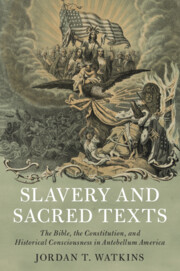 Slavery and Sacred Texts
Slavery and Sacred Texts Published online by Cambridge University Press: 12 June 2021
This chapter shifts the focus to the Constitution by tracking the emergence of historical readings of the Constitution and showing how debates over slavery drew attention to the historical realities of change since and distance from the founding era. The very act of producing a written constitution initiated this development. At first, the move to see the new Constitution as archival contributed to its status as a sacred document, but that move also had the potential to rapidly desacralize the Constitution by revealing that its roots rested in a distinct temporal setting. The death of James Madison in 1836 sparked efforts to publish and use his writings to interpret the Constitution. The slavery debates shaped that usage. Some abolitionists followed William Lloyd Garrison in using Madison’s Papers to damn the Constitution, but many antislavery constitutionalists advanced interpretations that emphasized the framers’ anticipation of eventual emancipation. Coupled with a stress on slavery’s unexpected spread and the sudden rise of the Slave Power, these antislavery accounts of original expectation cultivated a new sense of temporal dislocation from America’s most useful past.
To save this book to your Kindle, first ensure [email protected] is added to your Approved Personal Document E-mail List under your Personal Document Settings on the Manage Your Content and Devices page of your Amazon account. Then enter the ‘name’ part of your Kindle email address below. Find out more about saving to your Kindle.
Note you can select to save to either the @free.kindle.com or @kindle.com variations. ‘@free.kindle.com’ emails are free but can only be saved to your device when it is connected to wi-fi. ‘@kindle.com’ emails can be delivered even when you are not connected to wi-fi, but note that service fees apply.
Find out more about the Kindle Personal Document Service.
To save content items to your account, please confirm that you agree to abide by our usage policies. If this is the first time you use this feature, you will be asked to authorise Cambridge Core to connect with your account. Find out more about saving content to Dropbox.
To save content items to your account, please confirm that you agree to abide by our usage policies. If this is the first time you use this feature, you will be asked to authorise Cambridge Core to connect with your account. Find out more about saving content to Google Drive.